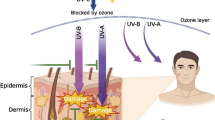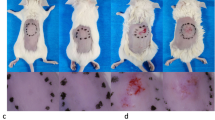Abstract
Wound healing becomes impaired in several diseases and during ageing. A commonly used model for the study of wound healing is a scratched monolayer of cells in vitro, which is convenient for the analysis of the cellular and molecular changes occurring during the two phases of wound healing, namely cell migration and cell proliferation. Cell migration, which is the primary event to occur during initial wound healing, is inversely dependent on the number of focal adhesions (FA) that attach cells to the extracellular matrix. Here we report that the number of FA, measured by determining the levels of FA-proteins paxillin and talin, increase with increasing population doubling level of the serially passaged normal adult skin fibroblasts, and that this increase may account for the age-related slowing down of wound healing in vitro. We also report that curcumin, a component of the widely used spice turmeric, modulates wound healing in vitro in a biphasic dose response manner, being stimulatory at low doses (between 1 and 5 μM), and inhibitory at higher doses. Furthermore, our results show that the hormetic effects of low levels of curcumin are achieved by virtue of it being a hormetin in terms of the induction of stress response pathways, including Nrf2 and HO-1 in human cells.







Similar content being viewed by others
References
Aggarwal BB, Harikumar KB (2009) Potential therapeutic effects of curcumin, the anti-inflammatory agent, against neurodegenerative, cardiovascular, pulmonary, metabolic, autoimmune and neoplastic diseases. Int J Biochem Cell Biol 41:40–59
Ali RE, Rattan SIS (2006) Curcumin’s biphasic hormetic response on proteasome activity and heat-shock protein synthesis in human keratinocytes. Ann NY Acad Sci 1067:394–399
Berge U, Kristensen P, Rattan SIS (2008) Hormetic modulation of differentiation of normal human epidermal keratinocytes undergoing replicative senescence in vitro. Exp Geront 43:658–662
Calabrese V, Cornelius C, Manusco C et al (2008) Cellular stress response: a novel target for chemoprevention and nutritional neuroprotection in aging, neurodegenerative disorders and longevity. Neurochem Res 33:2444–2471
Calabrese V, Cornelius C, Dinkova-Kostova AT et al (2010) Cellular stress responses, the hormesis paradigm and vitagenes: novel targets for therapeutic intervention in neurodegenerative disorders. Antioxid Redox Signal 13:1763–1811
Campisi J, D’Adda Di Fagagna F (2007) Cellular senescence: when bad things happen to good cells. Nat Rev Mol Cell Biol 8:729–740
Jovanovic SV, Steenken S, Boone CW, Simic MG (1999) H-atom transfer is a preferred antioxidant mechanism of curcumin. J Am Chem Soc 121:9677–9681
Jurjus RA, Liy Y, Pal-Gosh S, Tadvalkar G, Stepp MA (2008) Primary dermal fibroblasts derived from sdc-1 deficient mice migrate faster and have altered alpha-v integrin function. Wound Rep Reg 16:649–660
Liang C-C, Park AY, Guan L-J (2007) In vitro scratch assay: a convenient and inexpensive method for analysis of cell migration in vitro. Nat Protoc 2:329–333
Lima CF, Pereira-Wilson C, Rattan SIS (2010) Curcumin induces heme oxygenase-1 in normal human skin fibroblasts through redox signaling: relevance for anti-aging intervention. Mol Nutr Food Res 54:1–13
Mitra SK, Hanson DA, Schlaepfer DD (2005) Focal adhesion kinase: in command and control of cell motility. Mol Cell Biol 6:56–68
Rattan SIS (2008) Hormesis in aging. Ageing Res Rev 7:62–78
Rattan SIS (2010) Aging of skin cells in vitro. In: Farage MA et al (eds) Textbook of aging skin. Springer-Verlag, Berlin, pp 487–492
Rattan SIS, Sodagam L (2005) Gerontomodulatory and youth-preserving effects of zeatin on human skin fibroblasts undergoing aging in vitro. Rejuven Res 8:46–57
Rattan SIS, Sejersen H, Fernandes RA, Luo W (2007) Stress-mediated hormetic modulation of aging, wound healing, and angiogenesis in human cells. Ann NY Acad Sci 1119:112–121
Singh S, Vrishni S, Singh BK, Rahman I, Kakkar P (2010) Nrf2-ARE stress response mechanism: a control point in oxidative stress-mediated dysfunction and chronic inflammatory diseases. Free Rad Res 4:1267–1288
Author information
Authors and Affiliations
Corresponding author
Rights and permissions
About this article
Cite this article
Demirovic, D., Rattan, S.I.S. Curcumin induces stress response and hormetically modulates wound healing ability of human skin fibroblasts undergoing ageing in vitro. Biogerontology 12, 437–444 (2011). https://doi.org/10.1007/s10522-011-9326-7
Received:
Accepted:
Published:
Issue Date:
DOI: https://doi.org/10.1007/s10522-011-9326-7




